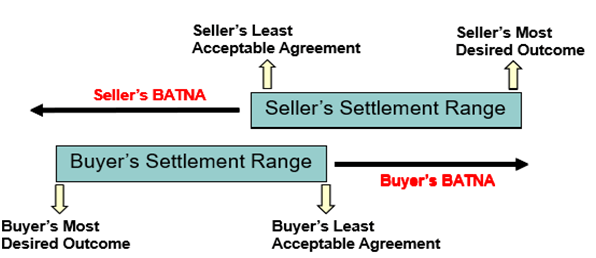Negotiation takes place almost every day in our daily life whether is it negotiating for a higher salary or for a better deal when shopping. These negotiations do not play a significant impact even if they are unsuccessful. However, it is not the same in the business context.
A good negotiation is absolutely vital to the success of a business especially in the increasingly competitive market. Whereas, a poor negotiation can potentially cause harm to the company as quickly as losing key customers or suppliers. Therefore, it is said that effective business negotiation is a core leadership and management skills.
Table of Contents
Procurement or Purchasing Negotiation
Procurement and purchasing are often used interchangeably but they do have different meanings. This terminology can be explained using the PP Organogram in the diagram below for a better understanding. Although both purchasing and procurement focuses on systems and processes, but procurement also concentrates on the interaction with both external suppliers and internal customers. Thus, this article will mainly be concentrating on procurement negotiation.

Create Win-Win Situations
Negotiating is not about defeating the other party but instead it is the ability to create a win-win situation whereby everyone leaves the negotiation feeling happy, thinking that they have achieve a good deal. The conflict table below demonstrates several possible negotiation outcomes. However, to have a successful negotiation it is always highly encouraging to achieve a win-win strategy. While, it is often difficult to satisfy everyone in a negotiation situation, and thus this is exactly why it is so highly valued. Therefore, the following sections will be covering in depth on what can be done so to achieve a win-win situation.

Preparation for Negotiation
It is often said that half the battle is already lost whenever a party enters a negotiation without proper preparation. Preparation is responsible for 90% of negotiating success thus there is no good shortcut although it is usually a very time-consuming process.
During preparation, always start with yourself first by recognizing what you want as well as the kind of outcome you want to achieve at the end of the negotiation. Of course, it is not enough to only identify your own interest or wants but it is also equally important to gather information and understand the other party’s needs, strengths and weaknesses. By doing so, chances of attaining success when negotiating will be raised as assessing the negotiation context will be easier, thus resulting in the development of an effective negotiation strategy. Certainly, when more preparation is done prior negotiation, the more likely it is that the result of the negotiation will be acceptable for all parties involved. Hence, it is necessary to constantly keep in mind that power is always on the side of the person with the best information.
The diagram below shows the negotiating envelope that should be develop before the start of any negotiation. However, as negotiation is a fluid process, it is required for individual to continuously refine the negotiating envelope throughout the whole negotiation process.

The BATNA Technique
“BATNA” is an acronym which stands for Best Alternative to a Negotiated Agreement. It is defined as the most advantageous alternative that an individual can take if an agreement cannot be made or when a negotiation fail.
Identifying and preparing your BATNA before entering a negotiation is always crucial. With a proper BATNA, it not only helps in providing an alternative if negotiation falls through, but also determines the reservation point (the worst you are willing to accept). Moreover, with a well thought BATNA it gives you a great amount of power during negotiation. However, it is not limited to only having one BATNA. The more BATNAs you have and the more willing and ready you are to execute one, the less likely you will need a BATNA.
The diagram below illustrates each party’s best alternative to a negotiated agreement in the seller and buyer perspective. The buyer’s settlement range is a biddable range acceptable to the buyer. If buyer offer price is lower than seller’s worst case, seller will use its BATNA. Whereas, seller’s settlement range is a biddable range acceptable to the buyer. If seller’s offer price is higher than buyer’s worst case, buyer will use its BATNA.

Active Listening
Active listening does not mean sitting down patiently to listen to the other party talk. Neither is it simply responding by saying “I understand” or keeping good eye contact. Instead, active listening is a process that requires undivided attention and concentration on the other party with the intention of understanding.
The full content is only visible to SIPMM members
Already a member? Please Login to continue reading.
References
Chew JinSwee, DPSM. (2018). “Essential Strategies for a Successful Procurement Negotiation”. Retrieved from SIPMM: https://publication.sipmm.edu.sg/essential-strategies-successful-procurement-negotiation, accessed 18/12/2019.
Corporate Finance Institute. (2019). “BATNA”. Retrieved from https://corporatefinanceinstitute.com/resources/knowledge/deals/what-is-batna/,accessed 19/12/2019.
Geoffrey Michael. (2019). “The Art of Negotiating”. Retrieved from https://www.entrepreneur.com/article/203168, accessed 28/11/2019.
MartinaMarof, DPMM (2018). “5 Critical Strategies for a Successful Procurement or Purchasing Negotiation”. Retrieved from https://publication.sipmm.edu.sg/5-critical-strategies-successful-procurement-purchasing-negotiation, accessed 28/11/2019.
Program on Negotiation. (2019). “Business Negotiations”. Retrieved from https://www.pon.harvard.edu/category/daily/business-negotiations/, accessed 28/11/2019.
Skillsyouneed (2019). “What is Negotiation?”. Retrieved from https://www.skillsyouneed.com/ips/negotiation.html, accessed 28/11/2019.
Watershed Associates. (2019). “The Negotiating Envelope” Retrieved from https://www.watershedassociates.com/learning-center-item/negotiating-envelope.html, accessed 19/12/ 2019.

